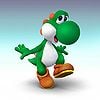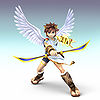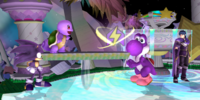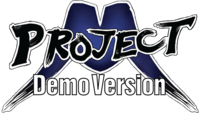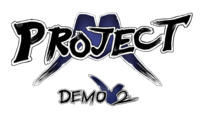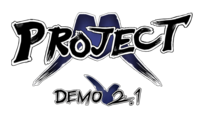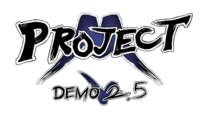Project M
Project M is a hack for Super Smash Bros. Brawl designed to make the gameplay more closely resemble that of Super Smash Bros. Melee mainly, and also Super Smash Bros. to a lesser extent. The development team is partly descended from the original developers for Brawl+, now known as the PMBR, or Project M Backroom. It has members from over ten countries, though as of now, only an NTSC version has been released.[1]
Project M has been featured as a prominent event at several national tournaments, such as GENESIS 2, the Zenith series, and is on the game lineup for Apex 2014.
Universal changes
The actual version of Project M has two versions: Full Set and Wi-Fi. The former has Stock Control and Input Assistance as new features, which allow newer players to use advanced techniques better and have a stock advantage over experienced ones. However, Replays and online play won't work properly; the latter can glitch since it still detects players with unmodded Brawl games, causing the game to freeze. A similar thing happens to replays; if a Project M replay is viewed on the regular Brawl, it may cause malfunctions when beggining a match, possibly because of the stage replacement. The Wi-Fi version allows these two things to work properly, though it doesn't contain the new battle features, likely because Stock Control would have caused potential griefing within online matches.
Both versions alter the original Brawl gameplay to be more resemblant to that of Melee, along with other changes to make the game more competitive in general, while keeping other Brawl beneficial techniques such as crawl, wall cling or DACUS. These changes include:
- Default match type is 4 stock with an 8-minute timer.
- The following mechanics have been altered to match their Melee forms:
- Air dodging applies a directional boost and causes helplessness, implementing wavedash techniques. Like in Brawl, however, they instantly grab nearby items during the first frames.
- L-canceling halves landing lag when a shield button is pressed 7 frames before landing, and characters will flash white if performed correctly.
- Dash dancing's timing has been reverted, and characters can shield during one.
- Crouching cancels dashes.
- Crouch canceling reduces knockback.
- Consecutive jabbing is removed.
- Hitting the C-Stick down while crouching uses a down smash (in Brawl it uses a down tilt).
- Double jump canceling reimplemented; its usage varies slightly between characters.
- The abilities to edge tech and edge cancel attacks have been implemented.
- Jumps can be cancelled with grabs.
- Powershielding can reflect projectiles during the first 2 frames.
- Shieldstun formula reverted.
- Edges cannot be auto-sweetspotted, so they cannot be grabbed neither from the back, nor during recovery attacks. Some moves like Raptor Boost or Bowser Bomb still use this feature, though.
- Window for teching reverted.
- Amount of freeze frames reduced.
- More forwards momentum is conserved when jumping.
- Altered camera that behaves similarly to in Melee's Camera Mode, as well as being capable of zooming out indefinitely, and rotating around the entire stage.
- Hitstun canceling has been removed.
- Random tripping has been removed.
- Grab aerials cause helplessness if they miss a ledge, but can be used after an air dodge with the shield + attack combination, like in Melee. They still act as tether recoveries, though they won't restore a character's midair jumps if they drop from the ledge. They are now also more efficient since they ignore edge-hoggers; characters will still grab the ledge without affecting them, and when pulled up they perform an automatic jump get-up.
- Characters now grunt instantly when hit by a strong attack, while in Brawl, they did a second afterwards. There are also medium-damage and high-damage groans as well, with most characters using unused voice samples from the Sound Test.
- If an already-struck character gets hit by something else, the new knockback either replaces the old knockback (if the gap between the attacks was 10 frames or less) or has its direction and power combined with the old knockback (after 10 frames). (In Brawl, whether to replace the old knockback is based on the relative power of the two attacks, and no merging is performed.)
- Brawl's random input delay is fixed.
- Meteor smash angle reverted, therefore implementing spikes.
- When dash-grabbing a foe, forward momentum is completely negated.
- Grab physics reverted: characters can grab opponents behind them, though they cannot be grabbed by the lower legs or arms.
- Locking is removed: characters hit when lying on the floor will instantly get up after bouncing.
- Footstool jumping is done with a taunt input.
- Tripping can be teched.
- A glide toss can be done in the air.
- Smash 64's taunt canceling returns.
- Gliding is no longer usable with a jump button: a special move must be used instead to do so.
- Stages such as Dream Land, Hyrule Castle and Fountain of Dreams replace stages such as Bridge of Eldin and 75m.
- For the Full Set version, players can now turn on Input Assistance which implements a 3 frame buffer window to help newer players master advanced techniques, replacing the "Damage Gauge" option. Wi-Fi version instead has a different Buffer option that replaces handicaps, from 1 to 30, with these numbers being the respective amount of buffer frames.
- Stock Control added (Full Set version), replacing handicaps. Players can now control the amount of stocks each player starts with before battle, from 1 to 30 stocks for each individual character. A Crew mode has been added in which the game keeps track of stocks retained after battles.
- Stage selection menu modified to include built-in stage striking control.
- Super Armor has been removed. Standardized knockback resistance system categorizes armor as Light, Medium, or Heavy. Some characters feature color overlays to indicate such armor, with more opaque overlays generally indicating stronger armor.
- Special Brawl's "Curry Mode" is replaced by "Turbo Mode," in which all moves can cancel into any other move or action on hit or on shield.
- Timers and Starmen are removed and replaced with ordinary stickers, even for Training mode. Superspicy Curry is replaced with an item that activates "Turbo Mode" on the spot. Other items remain unchanged, though.
Characters
Melee veterans
Melee veterans should be assumed to have been reverted to their Melee moveset and properties and have been changed from there. This includes special and normal moves, properties such as gravity, weight, run-speed, air mobility but does not include sound effects, textures, or vertexes. However, some characters, due to having poor attributes and movesets in Melee (such as Ness, Kirby or Zelda), had some elements recycled from Brawl and Smash 64 or have been given entirely new buffs.
List of characters
* Characters not in Brawl
Stages
- Battlefield
- Big Blue
- Brinstar
- Castle Siege (skips second stage)
- Dracula's Castle[2] (replaces Luigi's Mansion)
- Corneria
- Dreamland 64 (replaces Green Greens, as well as its theme with Smash 64's Dream Land theme.)
- Final Destination (with custom model and background resembling that of Melee's version)
- Flat Zone 2
- Fountain of Dreams (replaces Mario Bros., as well as its theme with Fountain of Dream's.)
- Fourside (replaces New Pork City, and replaces "Porky's Theme" with Fourside's.)
- Frigate Orpheon
- Green Hill Zone (Made into a neutral stage with 1 rotating platform. The Green Hill Zone of Brawl can be seen in the background.)
- Halberd
- Hyrule Castle (No tornado hazards; replaces Bridge of Eldin. Also replaces "The Hidden Village" theme with Hyrule Castle's.)
- Jungle Japes
- Kongo Jungle (Replaces 75 m. Also replaces "25 BGM" theme with Kongo Jungle's.)
- Lylat Cruise
- Peach's Castle (Replaces Mario Circuit)
- Metal Cavern (Remade Meta Crystal, replaces Mushroomy Kingdom. Also replaces "Ground Theme (Super Mario Bros.)" theme with Meta Crystal music from Smash 64.)
- Norfair (different layout with no hazards)
- Onett
- Pictochat
- Pirate Ship
- Pokémon Stadium 2 (no stage transformations)
- Pokémon Stadium
- Rainbow Cruise
- Rumble Falls (made into a neutral stage with a bridge and 3 platforms)
- Saffron City (No Pokémon; replaces Spear Pillar, as well as "Victory Road" theme with Saffron City's.)
- Shadow Moses Island
- Skyloft[3] (replaces Hanenbow, using "Hyrule Field Theme")
- Skyworld (without breakable platforms)
- Smashville
- SSE Jungle (the final stage in The Lake, replaces Distant Planet, revamped in 3.0 to resemble Distant Planet.)
- Summit
- Temple
- Training Room (Replaces Online Practice Stage)
- Warioware (without microgames)
- Yoshi's Island (SSBB)
- Yoshi's Story (replaces Yoshi's Island (SSBM), as well as "Super Mario Bros. 3" theme with Yoshi's Story's.)
Turbo Mode
As of version 3.0, the Curry effect is replaced with a new one - Turbo. In Turbo mode, players are able to cancel any successful attack, upon hit or shield, into any other action except the same attack. However, certain moves, such as Farore's Wind, consist of multiple actions and can be cancelled into themselves. Turbo Mode has been compared to the Marvel vs. Capcom series, because it enables skilled players to perform extensive combos.
Turbo mode can be selected from the Special Brawl menu, or temporarily granted by the "Turbo" item, which replaces Superspicy Curry.
Notable Turbo-related resources:
- The official Turbo Mode blog post.
- Melee Impossible, the original inspiration for Turbo Mode.
- The official Turbo Tuesdays playlist, beginning with the April Fools video that revealed Turbo mode.
- Going Turbo, by Sethlon. The first Turbo combo video to feature no tool assisted inputs.
Release history
Demo 1.0
Released February 8, 2011
- 14 characters available
Demo 2.0
Released April 17, 2012
- Added 15 characters
Demo 2.1
Released May 23, 2012
- Major bug fixes
Demo 2.5
Released December 29, 2012
- Added 4 characters
- Ledge Teching implemented
- Melee Knockback Stacking implemented
- Input Assistance implemented
- Stock Control implemented
- New aesthetic changes which include new palette swaps and new menu designs.
Demo 2.5b
Released January 6, 2013
- Various Minor Bug Fixes
Demo 2.6
Released July 17, 2013
- Added 1 character
The PMBR announced Project M 2.6 along with their new website design.
Demo 2.6b
Released August 15, 2013
- Various Bug Fixes
Demo 3.0
Released December 9, 2013
- Added 7 characters
- Turbo mode added.
- Princess Peach's Castle added, Norfair revamped, Distant Planet revamped. Another stage that seems to resemble a Project M Online Practice Stage has been confirmed too.
- Numerous alternate costumes for several characters added, including Dr. Mario.
An April Fools' video[4] announced that 3.0 would contain a universal gameplay change where all moves can cancel into any other move or action on hit or on shield. While the change being universal was a joke, it will be available for play as "Turbo Mode" in Special Brawl, replacing the "Curry" option. Project M 3.0 will mark the first version to contain the entire Brawl roster, along with Roy and Mewtwo. 3.0 will also feature Dr. Mario as an alternate skin for Mario, akin to Wario's biker and plumber skins. Other confirmed skins are Melee Fox, Shadow Queen Peach, OoT Link, Dry Bowser, Party Hat and Pirate Hat Pikachu, armored Mewtwo, Mr. L, Virtual Boy R.O.B., Outset Toon Link, Pirate Wolf, Boxer Donkey Kong, Pajama Ness, Masked Man Lucas, Fire Peach, Melee Falco, and Concept Art Meta Knight.
Downloading instructions
Project M can be downloaded here and only requires a SD card, non-PAL Wii, and Brawl disc.
<youtube>AL_tz-ObIGM</youtube>
Developers
- Project Leaders: Shanus, SHeLL, Magus, Strong Bad, jiang, Shadic, haloedhero, Yeroc
- Magus: Magus
- Playtesters: Historically, the PMBR has had playtesters such as Hungrybox, Mango, Lucky, KirbyKaze, Amsah, and many more. The current playtester team consists of Gimpyfish62, TheReflexWonder, Fuzzyness, Professor Pro, Fly Amanita, and Jolteon, among many, many others.
- Graphics/Menu Design: FireBall Stars, ds22
- Animation: haloedhero, SiLeNtDo0m
- Stage Design: Mewtwo2000, Shadic, Vanguard, SOJ
Applications to the Project M Backroom can be made at the application subforum.
References
External Links
| Playable characters in Project M and Project+ | |
|---|---|
| Playable characters | Bowser (Giga Bowser) · Captain Falcon · Charizard · Diddy Kong · Donkey Kong · Falco · Fox · Ganondorf · Ice Climbers · Ike · Ivysaur · Jigglypuff · King Dedede · Kirby · Knuckles · Link · Lucario · Lucas · Luigi · Mario · Marth · Meta Knight · Mewtwo · Mr. Game & Watch · Ness · Olimar · Peach · Pikachu · Pit · R.O.B. · Roy · Samus · Sheik · Snake · Sonic · Squirtle · Toon Link · Wario (Wario-Man) · Wolf · Yoshi · Zelda · Zero Suit Samus |

![[1]](https://ssb.wiki.gallery/images/thumb/8/83/Mario_SSBB.jpg/95px-Mario_SSBB.jpg)



